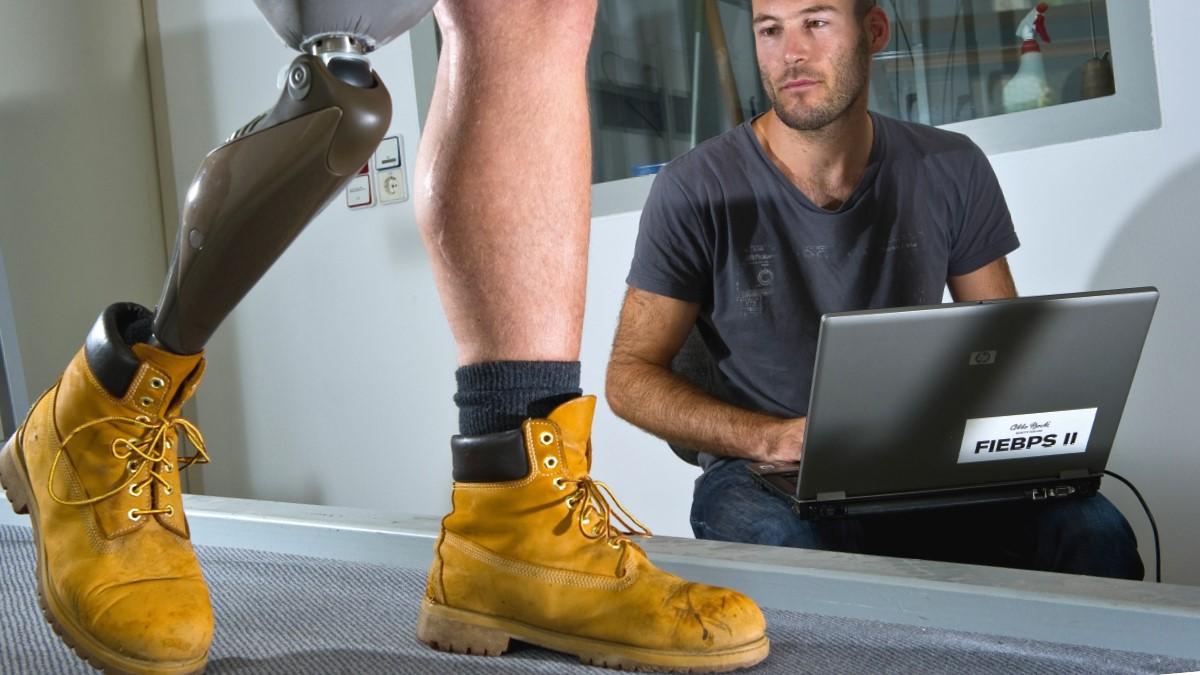Making sure trans-femoral amputees get the right prosthetic knee is essential says Helen Scott

Advances in lower limb prosthetics, using novel and innovative materials, have gathered apace in recent years allowing people who have lost limbs to maintain, or even improve on, previous levels of mobility, activity and independence. Microprocessor technology, which is also developing at an even faster rate, is contributing to the creation of even more sophisticated products.
These electronic knees feature sensors, a microprocessor, software, a resistance system and a battery. The microprocessor monitors each phase of the gait cycle using a series of sensors. The continuous monitoring allows the knee to make adjustments in resistance enabling the user to walk more efficiently at various speeds and improves safety when descending ramps and stairs. They have been shown to reduce falls and allow patients to walk more confidently and with less concentration. However mechanical knees are still widely prescribed as they do not require charging and can be easier to learn to use.
‘Polycentric knees’ have a centre of rotation based upon multiple linkages rather than being a simple hinge. Similar to the human knee, these knees have a variable centre of rotation during flexion of the knee. This may allow functional shortening of the limb during swing thus aiding toe clearance.
Hydraulic knees use a fluid similar to that in automotive breaking systems, and an array of valves, to change stance or swing resistance.
Matching people who have had a trans-femoral amputation with the prosthetic knee that helps them reach their full rehabilitation potential is essential. Making that match is challenging as there are so many devices on the market and the quantum rate of technological advance is driving new developments. With that in mind it is vital that clinical staff prescribing, fitting and training with these devices maintain an up to date knowledge of commonly prescribed prosthetic knees. The latest edition of the West of Scotland Mobility and Rehabilitation Centre (Westmarc) Knee Guide hopes to address all these issues.
The guide was re-written by myself and fellow specialist physiotherapist Nicola Porteous, prosthetists, Laura Brady, David Morrison and Alison Morton; and bioengineer, Bruce Carse. We are NHS clinicians who work together at Westmarc in Glasgow. We use the products described on a daily basis and have no commercial interest in their prescription or use. It is important to stress that we have not produced an evidence based guideline but it is informed by the expert opinion of clinical staff and guidance supplied by the manufacturers.
We also recognise that as advances prosthetic components and clinicians experience are evolving at a rapid pace, this document will require updating within the next 5 years. With that in mind we are also keen to receive ongoing feedback from professionals and patients and the guide includes full contact details.
Knee families
The guide starts with a detailed glossary of terms and gives information on the various categories or ‘families’ of knee joints, from relatively straightforward mechanical prostheses to the complex microprocessor controlled devices.
We have defined and described each category including examples of specific knees that fit into each category. These examples have been chosen as they are the most common types of knee used in clinical practise in the UK but they do not constitute a definitive list due to the number of prosthetic knees available.
Many knees will have similar features within their ‘family’ and the guide explains any significant differences. For more in-depth or practical training the reader should contact the manufacturer or supplier of each knee joint.
This edition is the second and expanded edition of the ‘Physiotherapist’s Guide to Prosthetic Knees’ published by Scottish Physiotherapy Amputee Research Group (SPARG) in 2007. Information on normal gait and prosthetic knees has been updated and more information on microprocessor technology has been included.
The hints and tips section is intended to facilitate problem solving when teaching patients to use a particular knee ensuring they gain maximum benefit from the different features and functions.
Quick reference guides
Also included in the guide are quick reference sheets designed to summarise important points from the body of the document. Each knee ‘family’ is represented with specific examples of knees within each category.
All the information supplied about each knee joint has been checked and approved by the appropriate manufacturer and is up to date at time of publishing. The authors are planning to include a review of the current evidence to support prescription guidance in the next edition.
We would like to express our thanks to John Colvin, Westmarc Clinical Services Manager and the wider prosthetic team in Westmarc without whose support we could not have completed this project.
Their contribution to many lively discussions and debates and their proof reading skills were invaluable. Also, fundamental to the accuracy of the guide was feedback from a group of expert advisors credited in the guide and the prosthetic companies themselves.
- Helen Scott is team leader physiotherapist and SPARG chairman Westmarc, Queen Elizabeth Hospital Campus, Glasgow
What the Westmarc Knee Guide
- Knee Guide is an electronic learning resource
- Regular updates
- Links to manufacturers’ training videos
- Detailed descriptions to aid correct knee prescription
- Understanding the type of knee ensures effective gait training
- Effective training means better outcomes for patient
Links
The West of Scotland Mobility and Rehabilitation Centre (Westmarc) Knee Guide for the Prosthetic Multidisciplinary Team is intended as a guide to assist the prosthetic multidisciplinary team. It was published electronically in May this year and is freely available from The Knowledge Network. The website also has links to manufacturer’s training videos and other related resources/organisations.
The knee guide is now located via the BACPAR website
Number of subscribers: 1




































